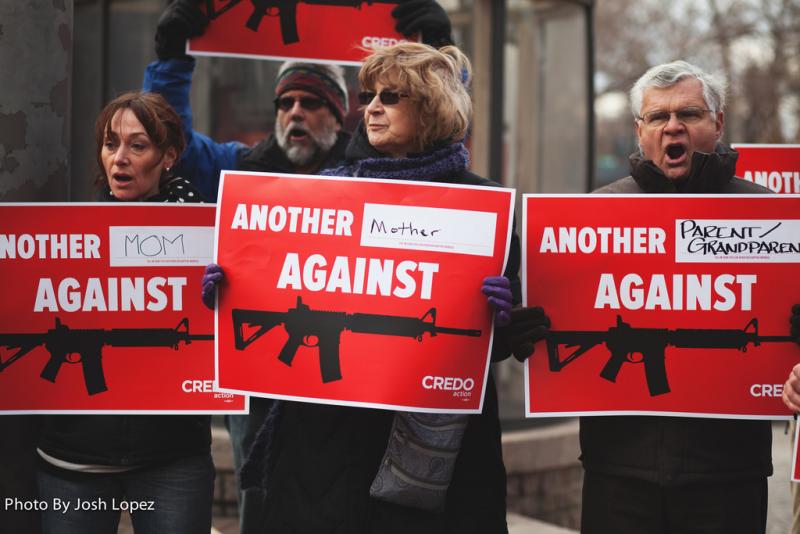Why Gun Policy Reform Isn’t As Polarizing As We Think

In the same way that the group of states' rights advocates who disagreed with the original draft of the Constitution were branded “anti-federalists,” it is clear that the label “gun control advocate” frightens every god-fearing pistol carrier south of the Mason-Dixon. In an attempt to explore reasonable policy options to deal with mass shootings, the term we use to describe these policies is a necessary starting point. That is why it may be more helpful to think of the proposals below as “gun policy reform.” They are not attempts at gun control in the same way that reforming Medicare funding is not an attempt to pull the plug on grandma.
Another necessary prior question worth examining is the Constitution. Be it due to ignorance or apathy, the absence of knowledge about the Supreme Court's stance on gun policy reform explains, in part, the current partisanship that characterizes the debate today. In short, here’s a newsflash: tomorrow morning, even if every member of Congress decided over their morning tea and "Wall Street Journal" that possession of every gun in America by civilians should be illegalized (remember, the Second Amendment only says militia), they couldn’t act.
That’s because of a Supreme Court decision on June 26, 2008 in District of Columbia v. Heller. The Court's decision, made by a 5-4 majority (surprise!), states that any law interfering with the possession and use of a firearm by a civilian for legal purposes (in this case, a D.C. law barring handgun registration) also interferes with the Second Amendment and is therefore unconstitutional. Because this decision applied to D.C. and not to an area where a state had jurisdiction, in McDonald v. Chicago, the Supreme Court used the Fourteenth Amendment’s due process clause to apply its decision in Heller to state governments and laws.
I sincerely hope that anyone who happens to be reading this article and packing heat can now breathe slightly easier. The policy reforms discussed below do not run afoul of the High Court’s decisions in either of the cases discussed above. Unless you are reading this with an assault weapon strapped to your back and a hundred-round ammunition clip in your underwear band, you need not worry. With that, I offer several options for gun policy reform that represent good faith efforts to reduce the loss of life from gun violence.
The government should reinstate the assault weapons ban that expired in 2004. This will certainly be recommended as a potential policy option when Vice President Joe Biden submits his recommendations for gun policy reform at the end of January. During the ban's active years, localities studied experienced a decrease in gun crimes involving assault weapons that was as high as 72 percent. Japan currently has an assault weapons ban (among other restrictions) and had 11 gun homicides last year. Yes, I said year. In Los Angeles, the LAPD considers 11 gun homicides a quiet weekend. Does this paragraph need to continue? Yet, the extent of the NRA’s influence on this issue should shock anyone concerned for democracy. In 1994, Washington congressman Jay Inslee cast the deciding vote that enacted the ban on assault weapons. The NRA rolled into Olympia, and Inslee was booted from office two years later.
The government should restrict the sale of high capacity ammunition clips. The shooting in Aurora, the shooting in Tucson, and the shooting in Newtown had in common, among other things, the use of an ammunition clip with a capacity above ten rounds. Restricting high capacity clips is a measure receiving broad support from the stakeholders attending meetings with Biden at the White House this week, and that support is not surprising. An assault weapons ban and the restriction of high capacity ammunition clips are rational, common sense policies that deal with the recent tragedies in logical fashion. The Second Amendment does not defend your right to prepare for the zombie apocalypse.
Thus far, a defining characteristic of the debate over gun policy reform has been ignorance to the problem. NRA President David Keene’s denouncement of an assault weapons ban and restrictions on high capacity ammunition clips as unnecessary is embarrassing. If Mr. Keene wants to cling to his AK-47 and tell himself over and over that “guns don’t kill people, people do,” then so be it, but it won’t do a damn bit of good for the 26 children who died last month. Don’t get me wrong: one of the few arguments from the NRA that I might be able to get on board with is that a citizen armed with a handgun might stop a shooting from getting worse. That’s all fine and well, but I won’t shut up about gun policy reform until a law-abiding citizen packing his assault rifle in public demonstrates its benefit to society. It’s time for Mr. Keene and those like him to stop embarrassingly defending the status quo at all costs—especially when those costs are human lives.



